Comprehensive Report on Internet of Things (IoT) Technologies
VerifiedAdded on 2021/05/31
|9
|4197
|107
Report
AI Summary
This report provides an overview of the Internet of Things (IoT), encompassing its definition, evolution, and significance across various industries. It delves into the economic impact of IoT, particularly in Australia, and highlights its potential for business transformation. The report examines the security challenges associated with IoT, including botnets, cyber-attacks, and vulnerabilities in connected devices. It discusses various security measures, such as IoT network security, authentication, PKI, security analytics, and API security. The report also explores the different domains of IoT and provides examples of real-world applications, like automated library management systems. The report emphasizes the importance of an end-to-end security approach, encryption, and security analytics, concluding with the potential of the IoT security market. The report also describes the four different layers of IoT: device, communication, lifecycle management.
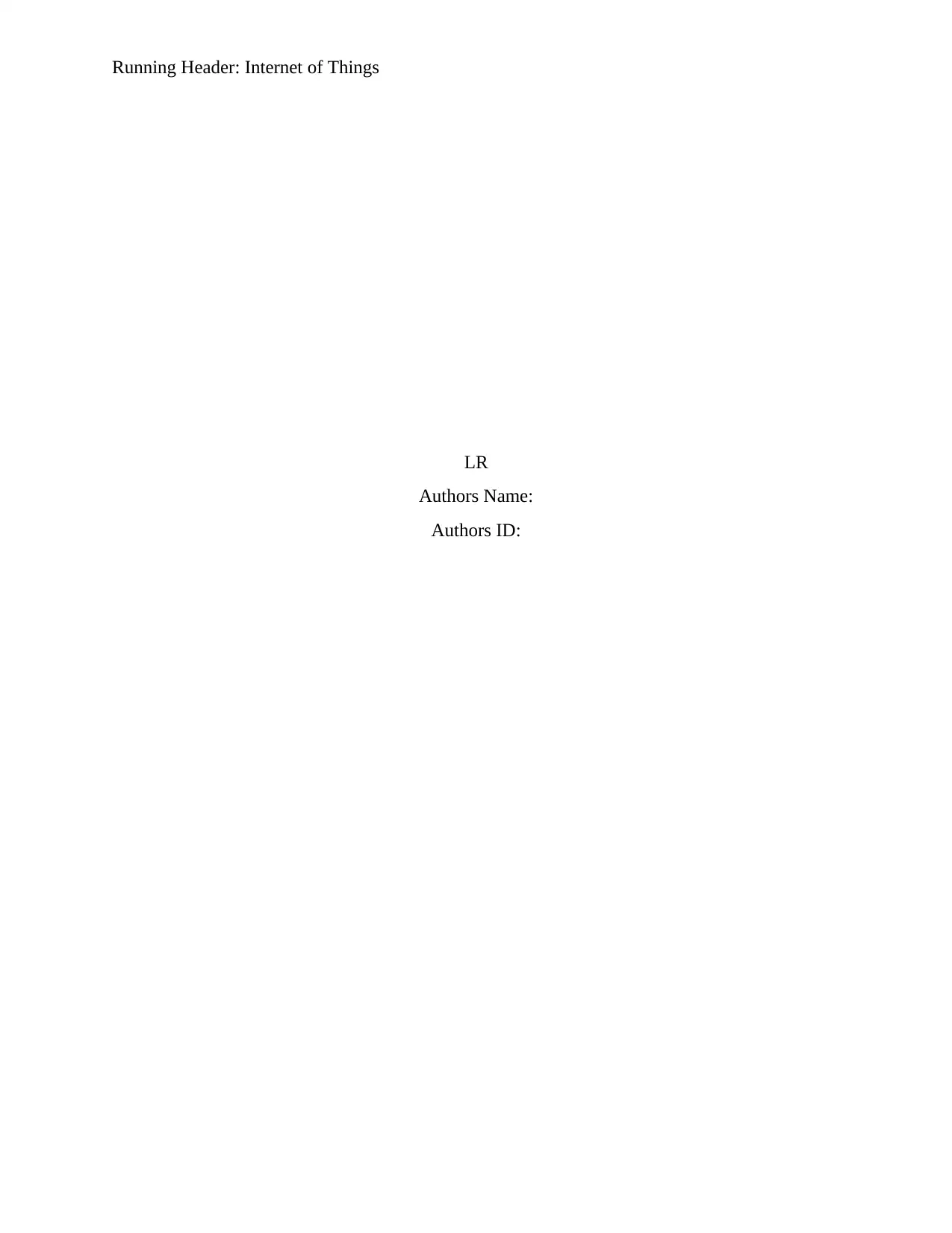
Running Header: Internet of Things
LR
Authors Name:
Authors ID:
LR
Authors Name:
Authors ID:
Paraphrase This Document
Need a fresh take? Get an instant paraphrase of this document with our AI Paraphraser
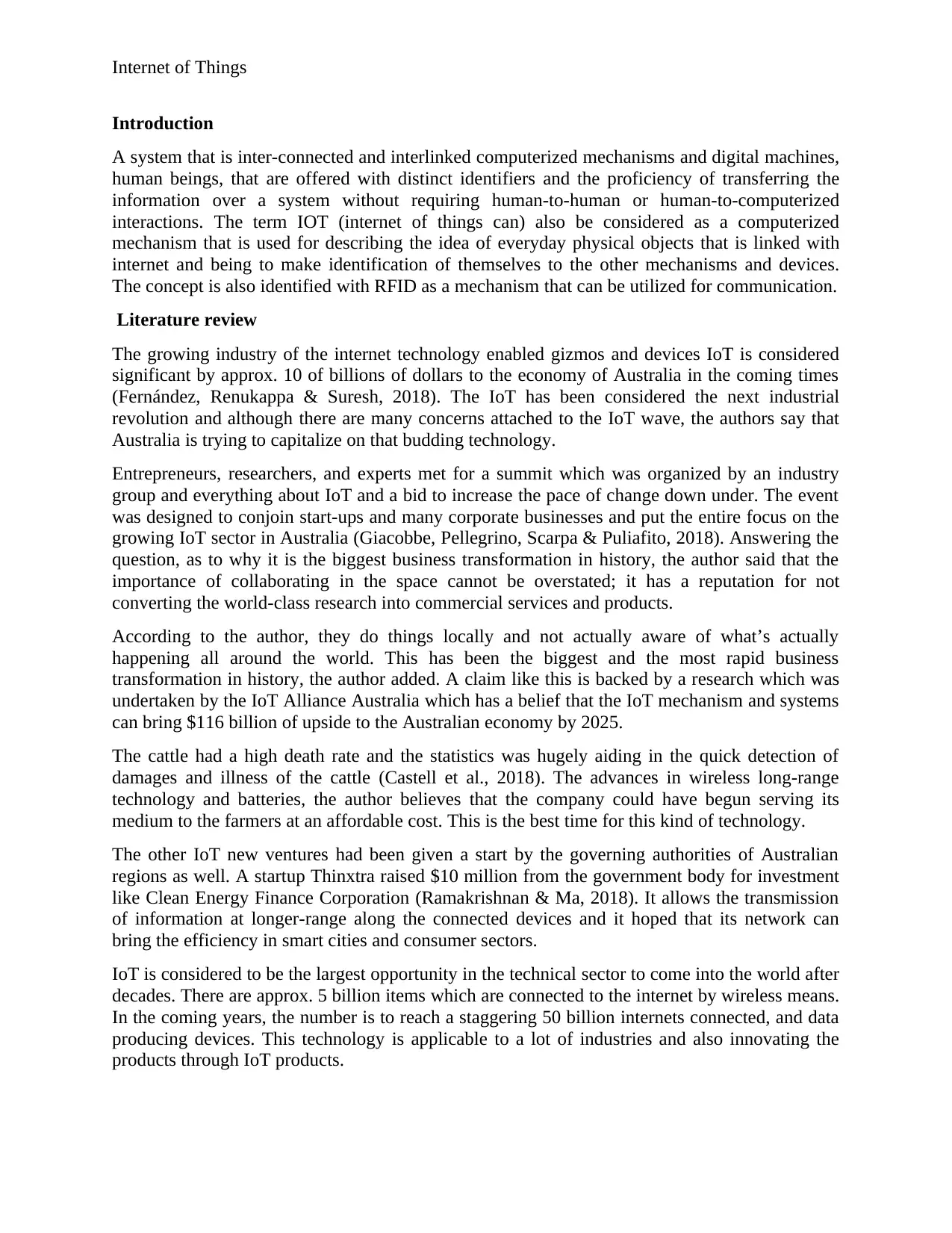
Internet of Things
Introduction
A system that is inter-connected and interlinked computerized mechanisms and digital machines,
human beings, that are offered with distinct identifiers and the proficiency of transferring the
information over a system without requiring human-to-human or human-to-computerized
interactions. The term IOT (internet of things can) also be considered as a computerized
mechanism that is used for describing the idea of everyday physical objects that is linked with
internet and being to make identification of themselves to the other mechanisms and devices.
The concept is also identified with RFID as a mechanism that can be utilized for communication.
Literature review
The growing industry of the internet technology enabled gizmos and devices IoT is considered
significant by approx. 10 of billions of dollars to the economy of Australia in the coming times
(Fernández, Renukappa & Suresh, 2018). The IoT has been considered the next industrial
revolution and although there are many concerns attached to the IoT wave, the authors say that
Australia is trying to capitalize on that budding technology.
Entrepreneurs, researchers, and experts met for a summit which was organized by an industry
group and everything about IoT and a bid to increase the pace of change down under. The event
was designed to conjoin start-ups and many corporate businesses and put the entire focus on the
growing IoT sector in Australia (Giacobbe, Pellegrino, Scarpa & Puliafito, 2018). Answering the
question, as to why it is the biggest business transformation in history, the author said that the
importance of collaborating in the space cannot be overstated; it has a reputation for not
converting the world-class research into commercial services and products.
According to the author, they do things locally and not actually aware of what’s actually
happening all around the world. This has been the biggest and the most rapid business
transformation in history, the author added. A claim like this is backed by a research which was
undertaken by the IoT Alliance Australia which has a belief that the IoT mechanism and systems
can bring $116 billion of upside to the Australian economy by 2025.
The cattle had a high death rate and the statistics was hugely aiding in the quick detection of
damages and illness of the cattle (Castell et al., 2018). The advances in wireless long-range
technology and batteries, the author believes that the company could have begun serving its
medium to the farmers at an affordable cost. This is the best time for this kind of technology.
The other IoT new ventures had been given a start by the governing authorities of Australian
regions as well. A startup Thinxtra raised $10 million from the government body for investment
like Clean Energy Finance Corporation (Ramakrishnan & Ma, 2018). It allows the transmission
of information at longer-range along the connected devices and it hoped that its network can
bring the efficiency in smart cities and consumer sectors.
IoT is considered to be the largest opportunity in the technical sector to come into the world after
decades. There are approx. 5 billion items which are connected to the internet by wireless means.
In the coming years, the number is to reach a staggering 50 billion internets connected, and data
producing devices. This technology is applicable to a lot of industries and also innovating the
products through IoT products.
Introduction
A system that is inter-connected and interlinked computerized mechanisms and digital machines,
human beings, that are offered with distinct identifiers and the proficiency of transferring the
information over a system without requiring human-to-human or human-to-computerized
interactions. The term IOT (internet of things can) also be considered as a computerized
mechanism that is used for describing the idea of everyday physical objects that is linked with
internet and being to make identification of themselves to the other mechanisms and devices.
The concept is also identified with RFID as a mechanism that can be utilized for communication.
Literature review
The growing industry of the internet technology enabled gizmos and devices IoT is considered
significant by approx. 10 of billions of dollars to the economy of Australia in the coming times
(Fernández, Renukappa & Suresh, 2018). The IoT has been considered the next industrial
revolution and although there are many concerns attached to the IoT wave, the authors say that
Australia is trying to capitalize on that budding technology.
Entrepreneurs, researchers, and experts met for a summit which was organized by an industry
group and everything about IoT and a bid to increase the pace of change down under. The event
was designed to conjoin start-ups and many corporate businesses and put the entire focus on the
growing IoT sector in Australia (Giacobbe, Pellegrino, Scarpa & Puliafito, 2018). Answering the
question, as to why it is the biggest business transformation in history, the author said that the
importance of collaborating in the space cannot be overstated; it has a reputation for not
converting the world-class research into commercial services and products.
According to the author, they do things locally and not actually aware of what’s actually
happening all around the world. This has been the biggest and the most rapid business
transformation in history, the author added. A claim like this is backed by a research which was
undertaken by the IoT Alliance Australia which has a belief that the IoT mechanism and systems
can bring $116 billion of upside to the Australian economy by 2025.
The cattle had a high death rate and the statistics was hugely aiding in the quick detection of
damages and illness of the cattle (Castell et al., 2018). The advances in wireless long-range
technology and batteries, the author believes that the company could have begun serving its
medium to the farmers at an affordable cost. This is the best time for this kind of technology.
The other IoT new ventures had been given a start by the governing authorities of Australian
regions as well. A startup Thinxtra raised $10 million from the government body for investment
like Clean Energy Finance Corporation (Ramakrishnan & Ma, 2018). It allows the transmission
of information at longer-range along the connected devices and it hoped that its network can
bring the efficiency in smart cities and consumer sectors.
IoT is considered to be the largest opportunity in the technical sector to come into the world after
decades. There are approx. 5 billion items which are connected to the internet by wireless means.
In the coming years, the number is to reach a staggering 50 billion internets connected, and data
producing devices. This technology is applicable to a lot of industries and also innovating the
products through IoT products.
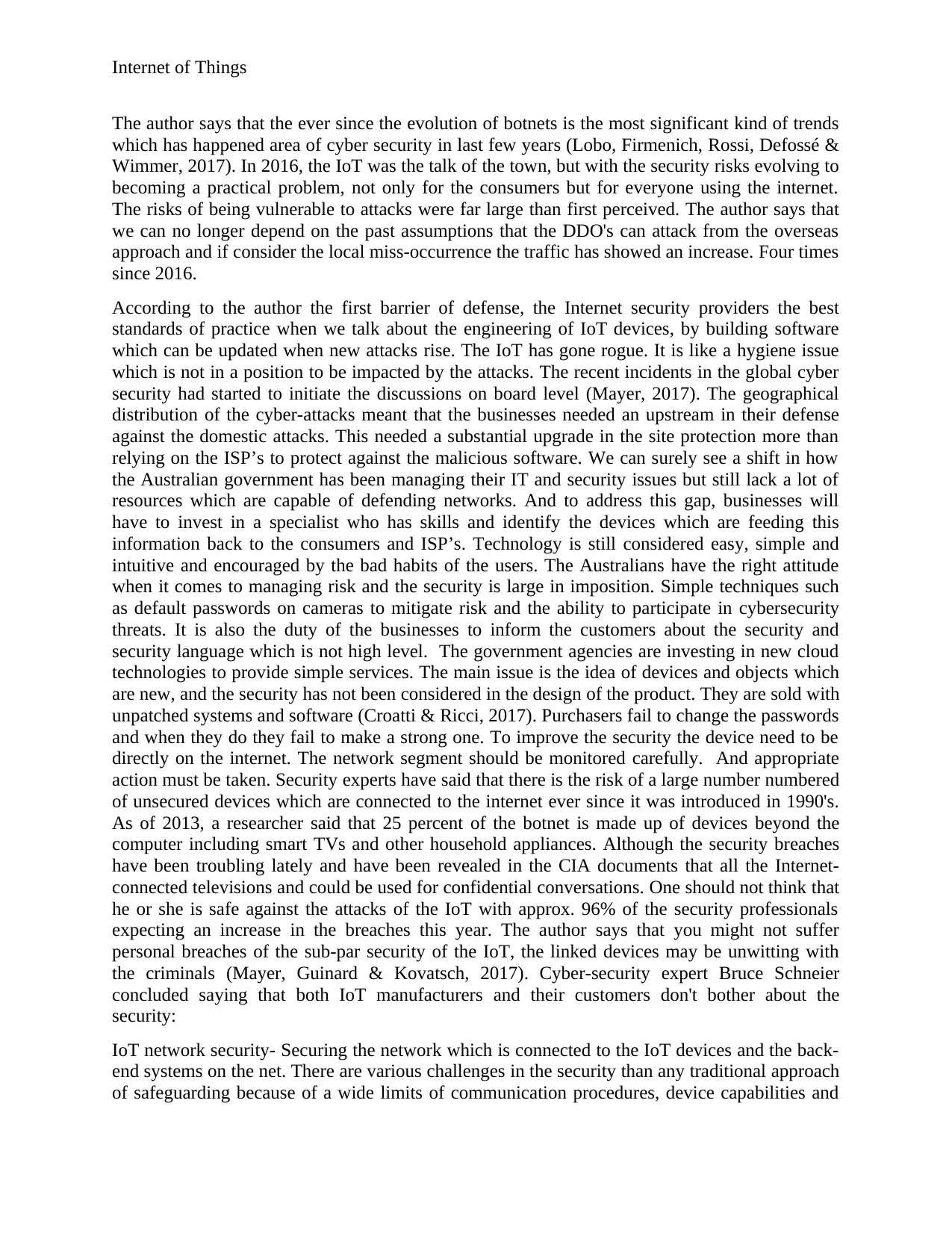
Internet of Things
The author says that the ever since the evolution of botnets is the most significant kind of trends
which has happened area of cyber security in last few years (Lobo, Firmenich, Rossi, Defossé &
Wimmer, 2017). In 2016, the IoT was the talk of the town, but with the security risks evolving to
becoming a practical problem, not only for the consumers but for everyone using the internet.
The risks of being vulnerable to attacks were far large than first perceived. The author says that
we can no longer depend on the past assumptions that the DDO's can attack from the overseas
approach and if consider the local miss-occurrence the traffic has showed an increase. Four times
since 2016.
According to the author the first barrier of defense, the Internet security providers the best
standards of practice when we talk about the engineering of IoT devices, by building software
which can be updated when new attacks rise. The IoT has gone rogue. It is like a hygiene issue
which is not in a position to be impacted by the attacks. The recent incidents in the global cyber
security had started to initiate the discussions on board level (Mayer, 2017). The geographical
distribution of the cyber-attacks meant that the businesses needed an upstream in their defense
against the domestic attacks. This needed a substantial upgrade in the site protection more than
relying on the ISP’s to protect against the malicious software. We can surely see a shift in how
the Australian government has been managing their IT and security issues but still lack a lot of
resources which are capable of defending networks. And to address this gap, businesses will
have to invest in a specialist who has skills and identify the devices which are feeding this
information back to the consumers and ISP’s. Technology is still considered easy, simple and
intuitive and encouraged by the bad habits of the users. The Australians have the right attitude
when it comes to managing risk and the security is large in imposition. Simple techniques such
as default passwords on cameras to mitigate risk and the ability to participate in cybersecurity
threats. It is also the duty of the businesses to inform the customers about the security and
security language which is not high level. The government agencies are investing in new cloud
technologies to provide simple services. The main issue is the idea of devices and objects which
are new, and the security has not been considered in the design of the product. They are sold with
unpatched systems and software (Croatti & Ricci, 2017). Purchasers fail to change the passwords
and when they do they fail to make a strong one. To improve the security the device need to be
directly on the internet. The network segment should be monitored carefully. And appropriate
action must be taken. Security experts have said that there is the risk of a large number numbered
of unsecured devices which are connected to the internet ever since it was introduced in 1990's.
As of 2013, a researcher said that 25 percent of the botnet is made up of devices beyond the
computer including smart TVs and other household appliances. Although the security breaches
have been troubling lately and have been revealed in the CIA documents that all the Internet-
connected televisions and could be used for confidential conversations. One should not think that
he or she is safe against the attacks of the IoT with approx. 96% of the security professionals
expecting an increase in the breaches this year. The author says that you might not suffer
personal breaches of the sub-par security of the IoT, the linked devices may be unwitting with
the criminals (Mayer, Guinard & Kovatsch, 2017). Cyber-security expert Bruce Schneier
concluded saying that both IoT manufacturers and their customers don't bother about the
security:
IoT network security- Securing the network which is connected to the IoT devices and the back-
end systems on the net. There are various challenges in the security than any traditional approach
of safeguarding because of a wide limits of communication procedures, device capabilities and
The author says that the ever since the evolution of botnets is the most significant kind of trends
which has happened area of cyber security in last few years (Lobo, Firmenich, Rossi, Defossé &
Wimmer, 2017). In 2016, the IoT was the talk of the town, but with the security risks evolving to
becoming a practical problem, not only for the consumers but for everyone using the internet.
The risks of being vulnerable to attacks were far large than first perceived. The author says that
we can no longer depend on the past assumptions that the DDO's can attack from the overseas
approach and if consider the local miss-occurrence the traffic has showed an increase. Four times
since 2016.
According to the author the first barrier of defense, the Internet security providers the best
standards of practice when we talk about the engineering of IoT devices, by building software
which can be updated when new attacks rise. The IoT has gone rogue. It is like a hygiene issue
which is not in a position to be impacted by the attacks. The recent incidents in the global cyber
security had started to initiate the discussions on board level (Mayer, 2017). The geographical
distribution of the cyber-attacks meant that the businesses needed an upstream in their defense
against the domestic attacks. This needed a substantial upgrade in the site protection more than
relying on the ISP’s to protect against the malicious software. We can surely see a shift in how
the Australian government has been managing their IT and security issues but still lack a lot of
resources which are capable of defending networks. And to address this gap, businesses will
have to invest in a specialist who has skills and identify the devices which are feeding this
information back to the consumers and ISP’s. Technology is still considered easy, simple and
intuitive and encouraged by the bad habits of the users. The Australians have the right attitude
when it comes to managing risk and the security is large in imposition. Simple techniques such
as default passwords on cameras to mitigate risk and the ability to participate in cybersecurity
threats. It is also the duty of the businesses to inform the customers about the security and
security language which is not high level. The government agencies are investing in new cloud
technologies to provide simple services. The main issue is the idea of devices and objects which
are new, and the security has not been considered in the design of the product. They are sold with
unpatched systems and software (Croatti & Ricci, 2017). Purchasers fail to change the passwords
and when they do they fail to make a strong one. To improve the security the device need to be
directly on the internet. The network segment should be monitored carefully. And appropriate
action must be taken. Security experts have said that there is the risk of a large number numbered
of unsecured devices which are connected to the internet ever since it was introduced in 1990's.
As of 2013, a researcher said that 25 percent of the botnet is made up of devices beyond the
computer including smart TVs and other household appliances. Although the security breaches
have been troubling lately and have been revealed in the CIA documents that all the Internet-
connected televisions and could be used for confidential conversations. One should not think that
he or she is safe against the attacks of the IoT with approx. 96% of the security professionals
expecting an increase in the breaches this year. The author says that you might not suffer
personal breaches of the sub-par security of the IoT, the linked devices may be unwitting with
the criminals (Mayer, Guinard & Kovatsch, 2017). Cyber-security expert Bruce Schneier
concluded saying that both IoT manufacturers and their customers don't bother about the
security:
IoT network security- Securing the network which is connected to the IoT devices and the back-
end systems on the net. There are various challenges in the security than any traditional approach
of safeguarding because of a wide limits of communication procedures, device capabilities and
⊘ This is a preview!⊘
Do you want full access?
Subscribe today to unlock all pages.

Trusted by 1+ million students worldwide
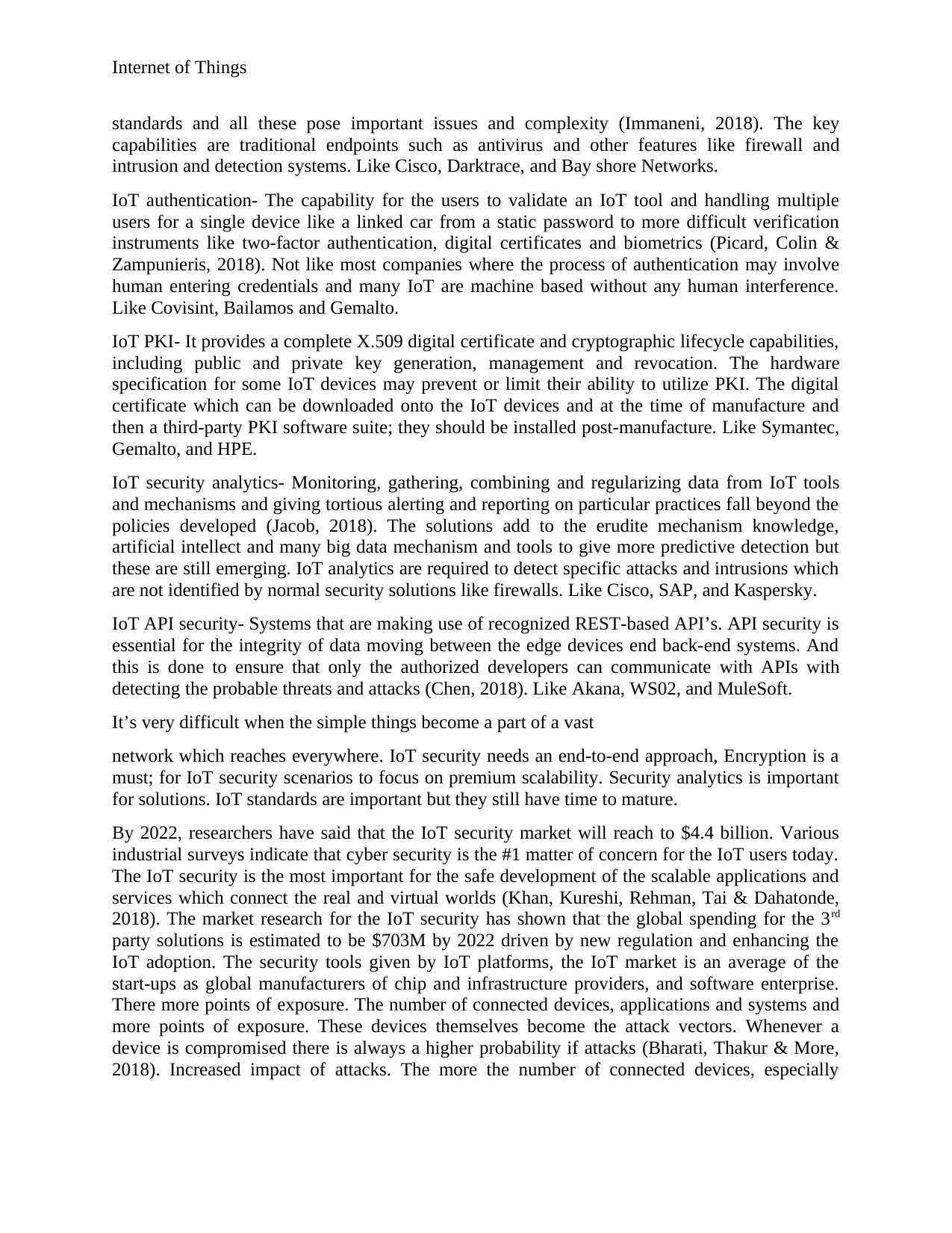
Internet of Things
standards and all these pose important issues and complexity (Immaneni, 2018). The key
capabilities are traditional endpoints such as antivirus and other features like firewall and
intrusion and detection systems. Like Cisco, Darktrace, and Bay shore Networks.
IoT authentication- The capability for the users to validate an IoT tool and handling multiple
users for a single device like a linked car from a static password to more difficult verification
instruments like two-factor authentication, digital certificates and biometrics (Picard, Colin &
Zampunieris, 2018). Not like most companies where the process of authentication may involve
human entering credentials and many IoT are machine based without any human interference.
Like Covisint, Bailamos and Gemalto.
IoT PKI- It provides a complete X.509 digital certificate and cryptographic lifecycle capabilities,
including public and private key generation, management and revocation. The hardware
specification for some IoT devices may prevent or limit their ability to utilize PKI. The digital
certificate which can be downloaded onto the IoT devices and at the time of manufacture and
then a third-party PKI software suite; they should be installed post-manufacture. Like Symantec,
Gemalto, and HPE.
IoT security analytics- Monitoring, gathering, combining and regularizing data from IoT tools
and mechanisms and giving tortious alerting and reporting on particular practices fall beyond the
policies developed (Jacob, 2018). The solutions add to the erudite mechanism knowledge,
artificial intellect and many big data mechanism and tools to give more predictive detection but
these are still emerging. IoT analytics are required to detect specific attacks and intrusions which
are not identified by normal security solutions like firewalls. Like Cisco, SAP, and Kaspersky.
IoT API security- Systems that are making use of recognized REST-based API’s. API security is
essential for the integrity of data moving between the edge devices end back-end systems. And
this is done to ensure that only the authorized developers can communicate with APIs with
detecting the probable threats and attacks (Chen, 2018). Like Akana, WS02, and MuleSoft.
It’s very difficult when the simple things become a part of a vast
network which reaches everywhere. IoT security needs an end-to-end approach, Encryption is a
must; for IoT security scenarios to focus on premium scalability. Security analytics is important
for solutions. IoT standards are important but they still have time to mature.
By 2022, researchers have said that the IoT security market will reach to $4.4 billion. Various
industrial surveys indicate that cyber security is the #1 matter of concern for the IoT users today.
The IoT security is the most important for the safe development of the scalable applications and
services which connect the real and virtual worlds (Khan, Kureshi, Rehman, Tai & Dahatonde,
2018). The market research for the IoT security has shown that the global spending for the 3rd
party solutions is estimated to be $703M by 2022 driven by new regulation and enhancing the
IoT adoption. The security tools given by IoT platforms, the IoT market is an average of the
start-ups as global manufacturers of chip and infrastructure providers, and software enterprise.
There more points of exposure. The number of connected devices, applications and systems and
more points of exposure. These devices themselves become the attack vectors. Whenever a
device is compromised there is always a higher probability if attacks (Bharati, Thakur & More,
2018). Increased impact of attacks. The more the number of connected devices, especially
standards and all these pose important issues and complexity (Immaneni, 2018). The key
capabilities are traditional endpoints such as antivirus and other features like firewall and
intrusion and detection systems. Like Cisco, Darktrace, and Bay shore Networks.
IoT authentication- The capability for the users to validate an IoT tool and handling multiple
users for a single device like a linked car from a static password to more difficult verification
instruments like two-factor authentication, digital certificates and biometrics (Picard, Colin &
Zampunieris, 2018). Not like most companies where the process of authentication may involve
human entering credentials and many IoT are machine based without any human interference.
Like Covisint, Bailamos and Gemalto.
IoT PKI- It provides a complete X.509 digital certificate and cryptographic lifecycle capabilities,
including public and private key generation, management and revocation. The hardware
specification for some IoT devices may prevent or limit their ability to utilize PKI. The digital
certificate which can be downloaded onto the IoT devices and at the time of manufacture and
then a third-party PKI software suite; they should be installed post-manufacture. Like Symantec,
Gemalto, and HPE.
IoT security analytics- Monitoring, gathering, combining and regularizing data from IoT tools
and mechanisms and giving tortious alerting and reporting on particular practices fall beyond the
policies developed (Jacob, 2018). The solutions add to the erudite mechanism knowledge,
artificial intellect and many big data mechanism and tools to give more predictive detection but
these are still emerging. IoT analytics are required to detect specific attacks and intrusions which
are not identified by normal security solutions like firewalls. Like Cisco, SAP, and Kaspersky.
IoT API security- Systems that are making use of recognized REST-based API’s. API security is
essential for the integrity of data moving between the edge devices end back-end systems. And
this is done to ensure that only the authorized developers can communicate with APIs with
detecting the probable threats and attacks (Chen, 2018). Like Akana, WS02, and MuleSoft.
It’s very difficult when the simple things become a part of a vast
network which reaches everywhere. IoT security needs an end-to-end approach, Encryption is a
must; for IoT security scenarios to focus on premium scalability. Security analytics is important
for solutions. IoT standards are important but they still have time to mature.
By 2022, researchers have said that the IoT security market will reach to $4.4 billion. Various
industrial surveys indicate that cyber security is the #1 matter of concern for the IoT users today.
The IoT security is the most important for the safe development of the scalable applications and
services which connect the real and virtual worlds (Khan, Kureshi, Rehman, Tai & Dahatonde,
2018). The market research for the IoT security has shown that the global spending for the 3rd
party solutions is estimated to be $703M by 2022 driven by new regulation and enhancing the
IoT adoption. The security tools given by IoT platforms, the IoT market is an average of the
start-ups as global manufacturers of chip and infrastructure providers, and software enterprise.
There more points of exposure. The number of connected devices, applications and systems and
more points of exposure. These devices themselves become the attack vectors. Whenever a
device is compromised there is always a higher probability if attacks (Bharati, Thakur & More,
2018). Increased impact of attacks. The more the number of connected devices, especially
Paraphrase This Document
Need a fresh take? Get an instant paraphrase of this document with our AI Paraphraser
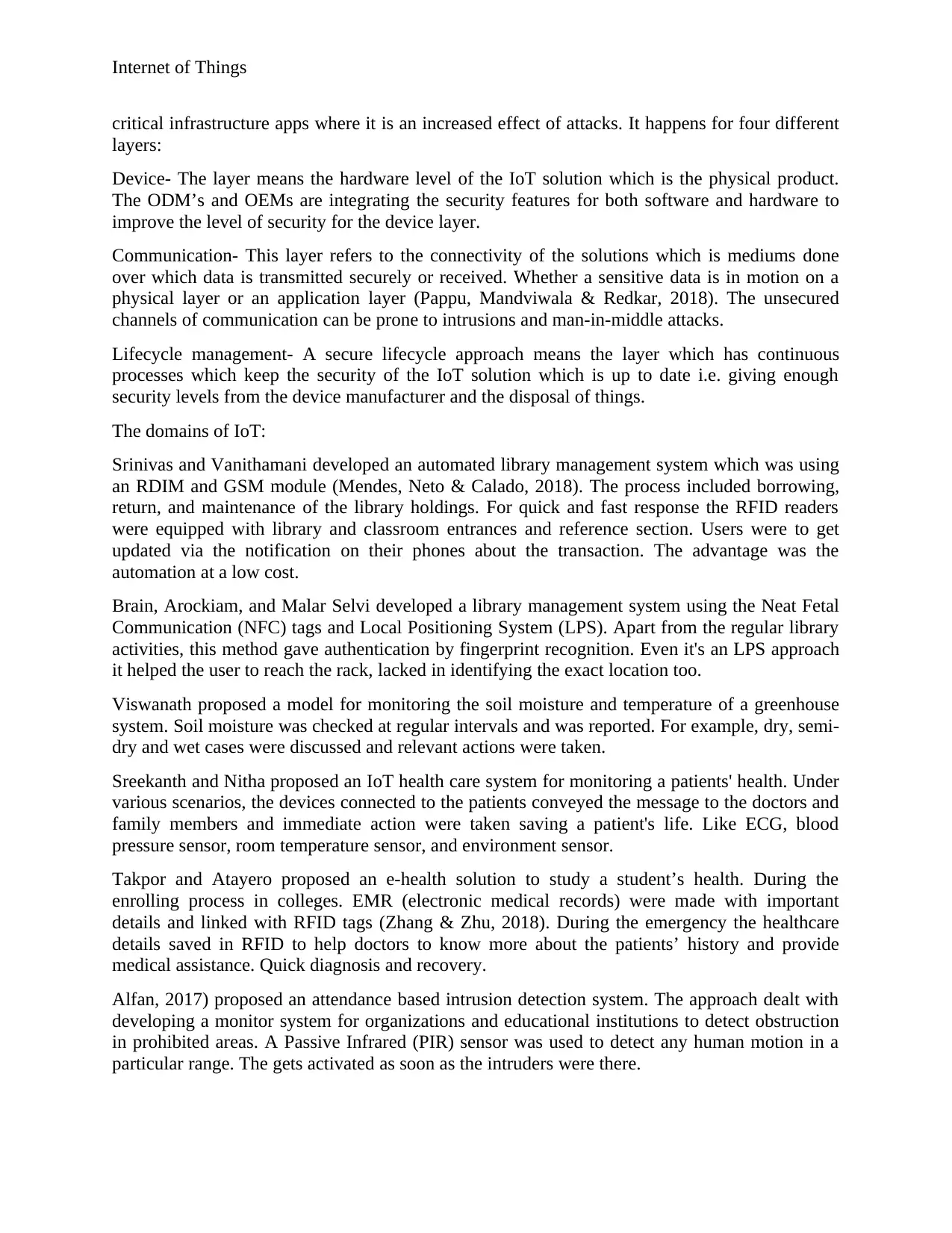
Internet of Things
critical infrastructure apps where it is an increased effect of attacks. It happens for four different
layers:
Device- The layer means the hardware level of the IoT solution which is the physical product.
The ODM’s and OEMs are integrating the security features for both software and hardware to
improve the level of security for the device layer.
Communication- This layer refers to the connectivity of the solutions which is mediums done
over which data is transmitted securely or received. Whether a sensitive data is in motion on a
physical layer or an application layer (Pappu, Mandviwala & Redkar, 2018). The unsecured
channels of communication can be prone to intrusions and man-in-middle attacks.
Lifecycle management- A secure lifecycle approach means the layer which has continuous
processes which keep the security of the IoT solution which is up to date i.e. giving enough
security levels from the device manufacturer and the disposal of things.
The domains of IoT:
Srinivas and Vanithamani developed an automated library management system which was using
an RDIM and GSM module (Mendes, Neto & Calado, 2018). The process included borrowing,
return, and maintenance of the library holdings. For quick and fast response the RFID readers
were equipped with library and classroom entrances and reference section. Users were to get
updated via the notification on their phones about the transaction. The advantage was the
automation at a low cost.
Brain, Arockiam, and Malar Selvi developed a library management system using the Neat Fetal
Communication (NFC) tags and Local Positioning System (LPS). Apart from the regular library
activities, this method gave authentication by fingerprint recognition. Even it's an LPS approach
it helped the user to reach the rack, lacked in identifying the exact location too.
Viswanath proposed a model for monitoring the soil moisture and temperature of a greenhouse
system. Soil moisture was checked at regular intervals and was reported. For example, dry, semi-
dry and wet cases were discussed and relevant actions were taken.
Sreekanth and Nitha proposed an IoT health care system for monitoring a patients' health. Under
various scenarios, the devices connected to the patients conveyed the message to the doctors and
family members and immediate action were taken saving a patient's life. Like ECG, blood
pressure sensor, room temperature sensor, and environment sensor.
Takpor and Atayero proposed an e-health solution to study a student’s health. During the
enrolling process in colleges. EMR (electronic medical records) were made with important
details and linked with RFID tags (Zhang & Zhu, 2018). During the emergency the healthcare
details saved in RFID to help doctors to know more about the patients’ history and provide
medical assistance. Quick diagnosis and recovery.
Alfan, 2017) proposed an attendance based intrusion detection system. The approach dealt with
developing a monitor system for organizations and educational institutions to detect obstruction
in prohibited areas. A Passive Infrared (PIR) sensor was used to detect any human motion in a
particular range. The gets activated as soon as the intruders were there.
critical infrastructure apps where it is an increased effect of attacks. It happens for four different
layers:
Device- The layer means the hardware level of the IoT solution which is the physical product.
The ODM’s and OEMs are integrating the security features for both software and hardware to
improve the level of security for the device layer.
Communication- This layer refers to the connectivity of the solutions which is mediums done
over which data is transmitted securely or received. Whether a sensitive data is in motion on a
physical layer or an application layer (Pappu, Mandviwala & Redkar, 2018). The unsecured
channels of communication can be prone to intrusions and man-in-middle attacks.
Lifecycle management- A secure lifecycle approach means the layer which has continuous
processes which keep the security of the IoT solution which is up to date i.e. giving enough
security levels from the device manufacturer and the disposal of things.
The domains of IoT:
Srinivas and Vanithamani developed an automated library management system which was using
an RDIM and GSM module (Mendes, Neto & Calado, 2018). The process included borrowing,
return, and maintenance of the library holdings. For quick and fast response the RFID readers
were equipped with library and classroom entrances and reference section. Users were to get
updated via the notification on their phones about the transaction. The advantage was the
automation at a low cost.
Brain, Arockiam, and Malar Selvi developed a library management system using the Neat Fetal
Communication (NFC) tags and Local Positioning System (LPS). Apart from the regular library
activities, this method gave authentication by fingerprint recognition. Even it's an LPS approach
it helped the user to reach the rack, lacked in identifying the exact location too.
Viswanath proposed a model for monitoring the soil moisture and temperature of a greenhouse
system. Soil moisture was checked at regular intervals and was reported. For example, dry, semi-
dry and wet cases were discussed and relevant actions were taken.
Sreekanth and Nitha proposed an IoT health care system for monitoring a patients' health. Under
various scenarios, the devices connected to the patients conveyed the message to the doctors and
family members and immediate action were taken saving a patient's life. Like ECG, blood
pressure sensor, room temperature sensor, and environment sensor.
Takpor and Atayero proposed an e-health solution to study a student’s health. During the
enrolling process in colleges. EMR (electronic medical records) were made with important
details and linked with RFID tags (Zhang & Zhu, 2018). During the emergency the healthcare
details saved in RFID to help doctors to know more about the patients’ history and provide
medical assistance. Quick diagnosis and recovery.
Alfan, 2017) proposed an attendance based intrusion detection system. The approach dealt with
developing a monitor system for organizations and educational institutions to detect obstruction
in prohibited areas. A Passive Infrared (PIR) sensor was used to detect any human motion in a
particular range. The gets activated as soon as the intruders were there.
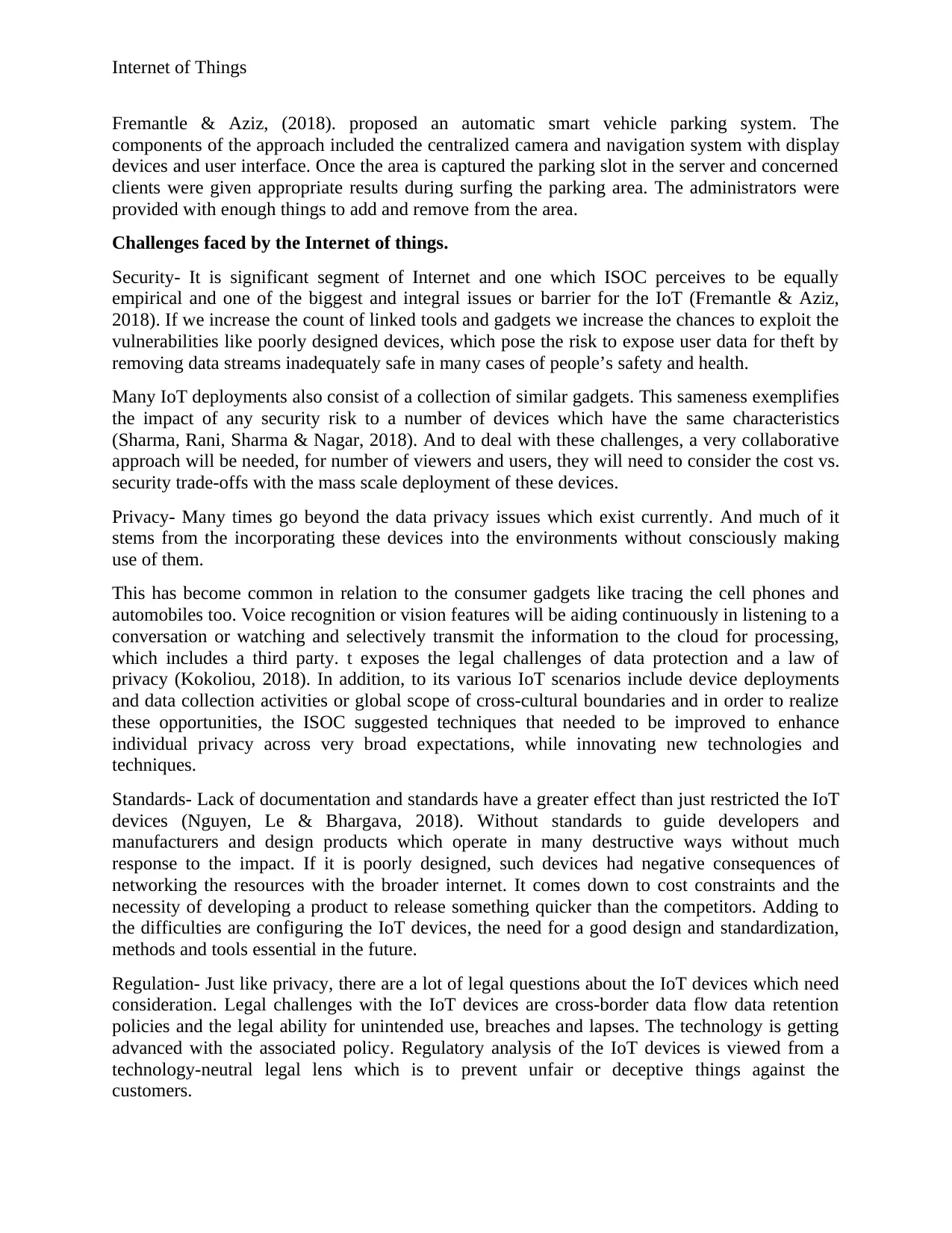
Internet of Things
Fremantle & Aziz, (2018). proposed an automatic smart vehicle parking system. The
components of the approach included the centralized camera and navigation system with display
devices and user interface. Once the area is captured the parking slot in the server and concerned
clients were given appropriate results during surfing the parking area. The administrators were
provided with enough things to add and remove from the area.
Challenges faced by the Internet of things.
Security- It is significant segment of Internet and one which ISOC perceives to be equally
empirical and one of the biggest and integral issues or barrier for the IoT (Fremantle & Aziz,
2018). If we increase the count of linked tools and gadgets we increase the chances to exploit the
vulnerabilities like poorly designed devices, which pose the risk to expose user data for theft by
removing data streams inadequately safe in many cases of people’s safety and health.
Many IoT deployments also consist of a collection of similar gadgets. This sameness exemplifies
the impact of any security risk to a number of devices which have the same characteristics
(Sharma, Rani, Sharma & Nagar, 2018). And to deal with these challenges, a very collaborative
approach will be needed, for number of viewers and users, they will need to consider the cost vs.
security trade-offs with the mass scale deployment of these devices.
Privacy- Many times go beyond the data privacy issues which exist currently. And much of it
stems from the incorporating these devices into the environments without consciously making
use of them.
This has become common in relation to the consumer gadgets like tracing the cell phones and
automobiles too. Voice recognition or vision features will be aiding continuously in listening to a
conversation or watching and selectively transmit the information to the cloud for processing,
which includes a third party. t exposes the legal challenges of data protection and a law of
privacy (Kokoliou, 2018). In addition, to its various IoT scenarios include device deployments
and data collection activities or global scope of cross-cultural boundaries and in order to realize
these opportunities, the ISOC suggested techniques that needed to be improved to enhance
individual privacy across very broad expectations, while innovating new technologies and
techniques.
Standards- Lack of documentation and standards have a greater effect than just restricted the IoT
devices (Nguyen, Le & Bhargava, 2018). Without standards to guide developers and
manufacturers and design products which operate in many destructive ways without much
response to the impact. If it is poorly designed, such devices had negative consequences of
networking the resources with the broader internet. It comes down to cost constraints and the
necessity of developing a product to release something quicker than the competitors. Adding to
the difficulties are configuring the IoT devices, the need for a good design and standardization,
methods and tools essential in the future.
Regulation- Just like privacy, there are a lot of legal questions about the IoT devices which need
consideration. Legal challenges with the IoT devices are cross-border data flow data retention
policies and the legal ability for unintended use, breaches and lapses. The technology is getting
advanced with the associated policy. Regulatory analysis of the IoT devices is viewed from a
technology-neutral legal lens which is to prevent unfair or deceptive things against the
customers.
Fremantle & Aziz, (2018). proposed an automatic smart vehicle parking system. The
components of the approach included the centralized camera and navigation system with display
devices and user interface. Once the area is captured the parking slot in the server and concerned
clients were given appropriate results during surfing the parking area. The administrators were
provided with enough things to add and remove from the area.
Challenges faced by the Internet of things.
Security- It is significant segment of Internet and one which ISOC perceives to be equally
empirical and one of the biggest and integral issues or barrier for the IoT (Fremantle & Aziz,
2018). If we increase the count of linked tools and gadgets we increase the chances to exploit the
vulnerabilities like poorly designed devices, which pose the risk to expose user data for theft by
removing data streams inadequately safe in many cases of people’s safety and health.
Many IoT deployments also consist of a collection of similar gadgets. This sameness exemplifies
the impact of any security risk to a number of devices which have the same characteristics
(Sharma, Rani, Sharma & Nagar, 2018). And to deal with these challenges, a very collaborative
approach will be needed, for number of viewers and users, they will need to consider the cost vs.
security trade-offs with the mass scale deployment of these devices.
Privacy- Many times go beyond the data privacy issues which exist currently. And much of it
stems from the incorporating these devices into the environments without consciously making
use of them.
This has become common in relation to the consumer gadgets like tracing the cell phones and
automobiles too. Voice recognition or vision features will be aiding continuously in listening to a
conversation or watching and selectively transmit the information to the cloud for processing,
which includes a third party. t exposes the legal challenges of data protection and a law of
privacy (Kokoliou, 2018). In addition, to its various IoT scenarios include device deployments
and data collection activities or global scope of cross-cultural boundaries and in order to realize
these opportunities, the ISOC suggested techniques that needed to be improved to enhance
individual privacy across very broad expectations, while innovating new technologies and
techniques.
Standards- Lack of documentation and standards have a greater effect than just restricted the IoT
devices (Nguyen, Le & Bhargava, 2018). Without standards to guide developers and
manufacturers and design products which operate in many destructive ways without much
response to the impact. If it is poorly designed, such devices had negative consequences of
networking the resources with the broader internet. It comes down to cost constraints and the
necessity of developing a product to release something quicker than the competitors. Adding to
the difficulties are configuring the IoT devices, the need for a good design and standardization,
methods and tools essential in the future.
Regulation- Just like privacy, there are a lot of legal questions about the IoT devices which need
consideration. Legal challenges with the IoT devices are cross-border data flow data retention
policies and the legal ability for unintended use, breaches and lapses. The technology is getting
advanced with the associated policy. Regulatory analysis of the IoT devices is viewed from a
technology-neutral legal lens which is to prevent unfair or deceptive things against the
customers.
⊘ This is a preview!⊘
Do you want full access?
Subscribe today to unlock all pages.

Trusted by 1+ million students worldwide
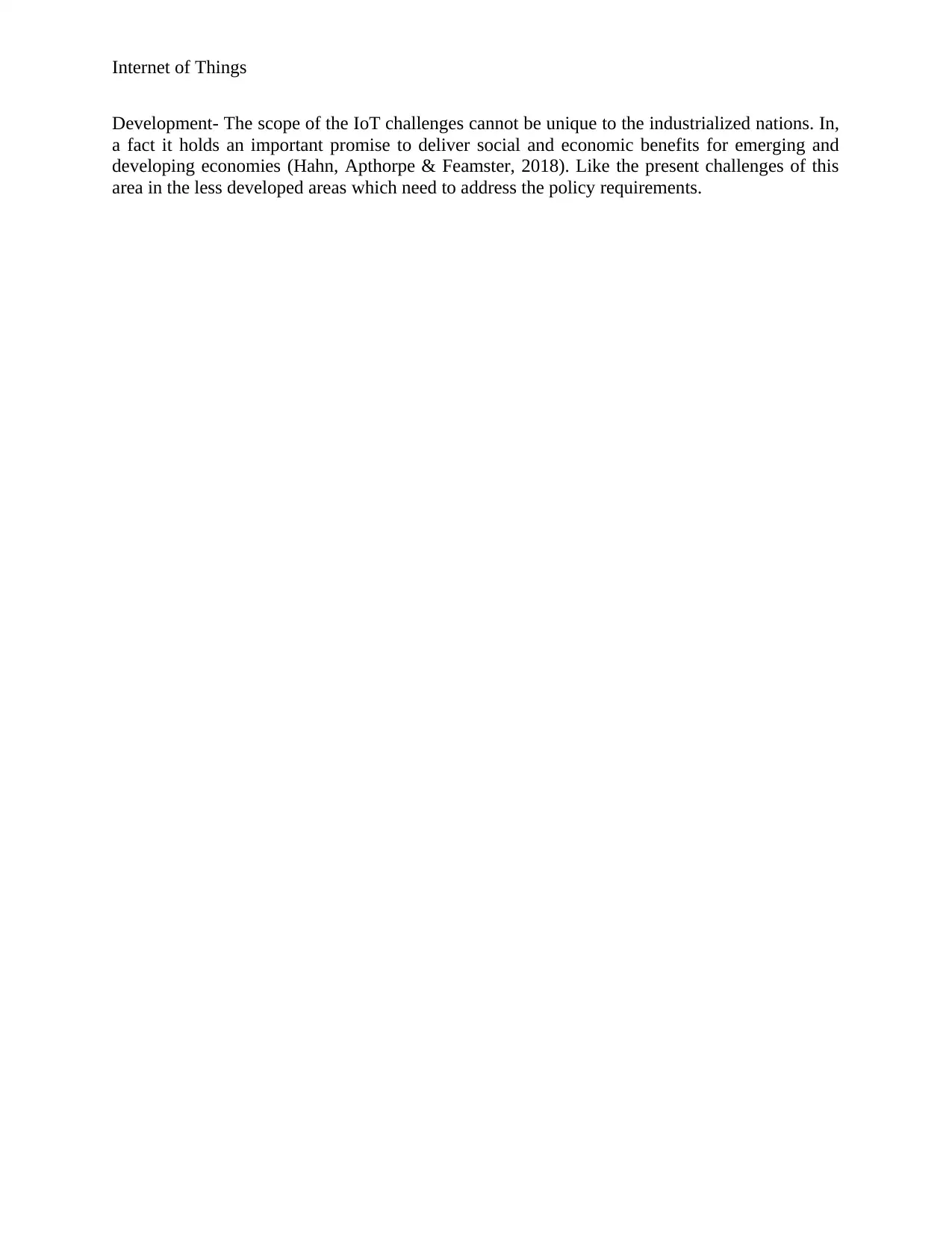
Internet of Things
Development- The scope of the IoT challenges cannot be unique to the industrialized nations. In,
a fact it holds an important promise to deliver social and economic benefits for emerging and
developing economies (Hahn, Apthorpe & Feamster, 2018). Like the present challenges of this
area in the less developed areas which need to address the policy requirements.
Development- The scope of the IoT challenges cannot be unique to the industrialized nations. In,
a fact it holds an important promise to deliver social and economic benefits for emerging and
developing economies (Hahn, Apthorpe & Feamster, 2018). Like the present challenges of this
area in the less developed areas which need to address the policy requirements.
Paraphrase This Document
Need a fresh take? Get an instant paraphrase of this document with our AI Paraphraser
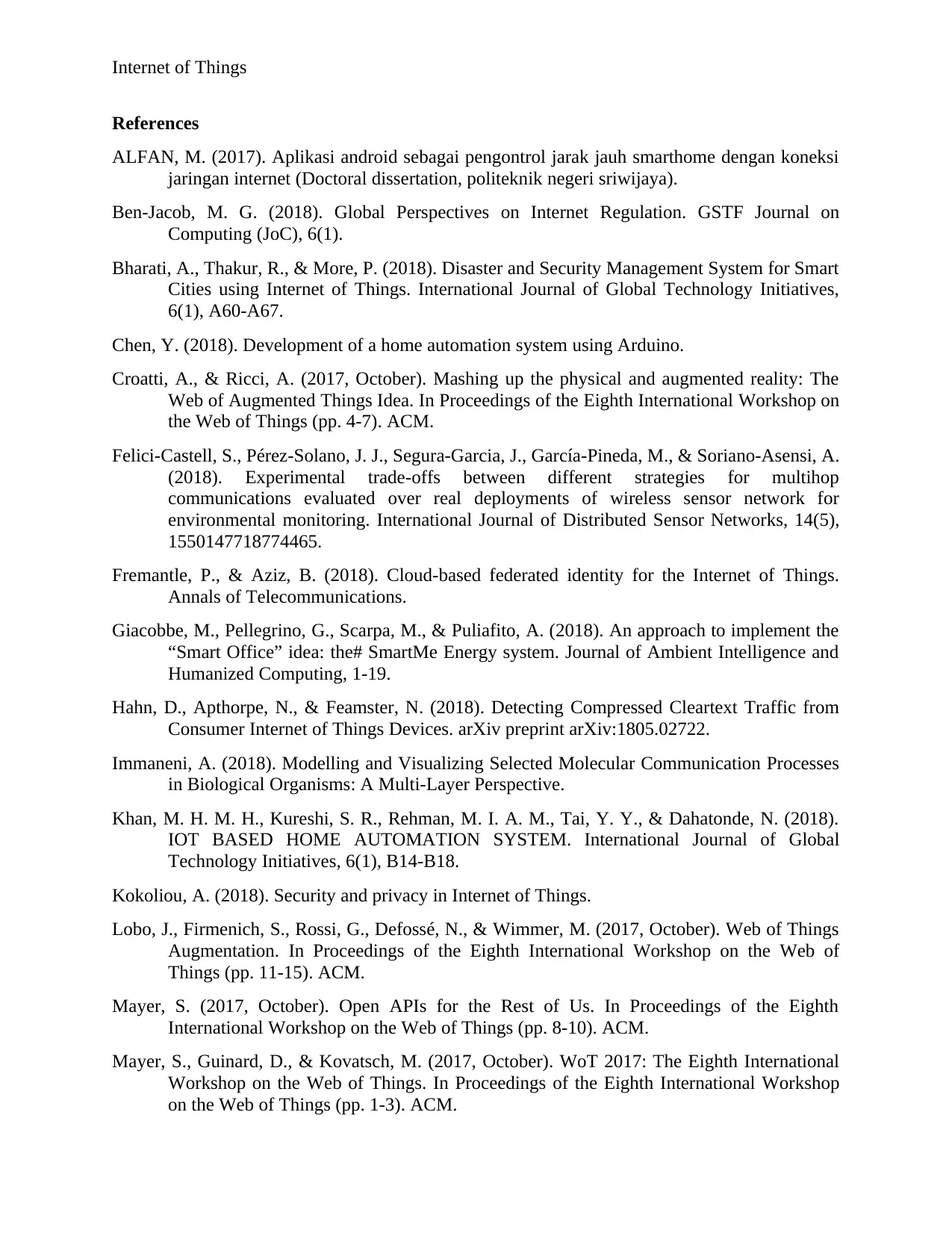
Internet of Things
References
ALFAN, M. (2017). Aplikasi android sebagai pengontrol jarak jauh smarthome dengan koneksi
jaringan internet (Doctoral dissertation, politeknik negeri sriwijaya).
Ben-Jacob, M. G. (2018). Global Perspectives on Internet Regulation. GSTF Journal on
Computing (JoC), 6(1).
Bharati, A., Thakur, R., & More, P. (2018). Disaster and Security Management System for Smart
Cities using Internet of Things. International Journal of Global Technology Initiatives,
6(1), A60-A67.
Chen, Y. (2018). Development of a home automation system using Arduino.
Croatti, A., & Ricci, A. (2017, October). Mashing up the physical and augmented reality: The
Web of Augmented Things Idea. In Proceedings of the Eighth International Workshop on
the Web of Things (pp. 4-7). ACM.
Felici-Castell, S., Pérez-Solano, J. J., Segura-Garcia, J., García-Pineda, M., & Soriano-Asensi, A.
(2018). Experimental trade-offs between different strategies for multihop
communications evaluated over real deployments of wireless sensor network for
environmental monitoring. International Journal of Distributed Sensor Networks, 14(5),
1550147718774465.
Fremantle, P., & Aziz, B. (2018). Cloud-based federated identity for the Internet of Things.
Annals of Telecommunications.
Giacobbe, M., Pellegrino, G., Scarpa, M., & Puliafito, A. (2018). An approach to implement the
“Smart Office” idea: the# SmartMe Energy system. Journal of Ambient Intelligence and
Humanized Computing, 1-19.
Hahn, D., Apthorpe, N., & Feamster, N. (2018). Detecting Compressed Cleartext Traffic from
Consumer Internet of Things Devices. arXiv preprint arXiv:1805.02722.
Immaneni, A. (2018). Modelling and Visualizing Selected Molecular Communication Processes
in Biological Organisms: A Multi-Layer Perspective.
Khan, M. H. M. H., Kureshi, S. R., Rehman, M. I. A. M., Tai, Y. Y., & Dahatonde, N. (2018).
IOT BASED HOME AUTOMATION SYSTEM. International Journal of Global
Technology Initiatives, 6(1), B14-B18.
Kokoliou, A. (2018). Security and privacy in Internet of Things.
Lobo, J., Firmenich, S., Rossi, G., Defossé, N., & Wimmer, M. (2017, October). Web of Things
Augmentation. In Proceedings of the Eighth International Workshop on the Web of
Things (pp. 11-15). ACM.
Mayer, S. (2017, October). Open APIs for the Rest of Us. In Proceedings of the Eighth
International Workshop on the Web of Things (pp. 8-10). ACM.
Mayer, S., Guinard, D., & Kovatsch, M. (2017, October). WoT 2017: The Eighth International
Workshop on the Web of Things. In Proceedings of the Eighth International Workshop
on the Web of Things (pp. 1-3). ACM.
References
ALFAN, M. (2017). Aplikasi android sebagai pengontrol jarak jauh smarthome dengan koneksi
jaringan internet (Doctoral dissertation, politeknik negeri sriwijaya).
Ben-Jacob, M. G. (2018). Global Perspectives on Internet Regulation. GSTF Journal on
Computing (JoC), 6(1).
Bharati, A., Thakur, R., & More, P. (2018). Disaster and Security Management System for Smart
Cities using Internet of Things. International Journal of Global Technology Initiatives,
6(1), A60-A67.
Chen, Y. (2018). Development of a home automation system using Arduino.
Croatti, A., & Ricci, A. (2017, October). Mashing up the physical and augmented reality: The
Web of Augmented Things Idea. In Proceedings of the Eighth International Workshop on
the Web of Things (pp. 4-7). ACM.
Felici-Castell, S., Pérez-Solano, J. J., Segura-Garcia, J., García-Pineda, M., & Soriano-Asensi, A.
(2018). Experimental trade-offs between different strategies for multihop
communications evaluated over real deployments of wireless sensor network for
environmental monitoring. International Journal of Distributed Sensor Networks, 14(5),
1550147718774465.
Fremantle, P., & Aziz, B. (2018). Cloud-based federated identity for the Internet of Things.
Annals of Telecommunications.
Giacobbe, M., Pellegrino, G., Scarpa, M., & Puliafito, A. (2018). An approach to implement the
“Smart Office” idea: the# SmartMe Energy system. Journal of Ambient Intelligence and
Humanized Computing, 1-19.
Hahn, D., Apthorpe, N., & Feamster, N. (2018). Detecting Compressed Cleartext Traffic from
Consumer Internet of Things Devices. arXiv preprint arXiv:1805.02722.
Immaneni, A. (2018). Modelling and Visualizing Selected Molecular Communication Processes
in Biological Organisms: A Multi-Layer Perspective.
Khan, M. H. M. H., Kureshi, S. R., Rehman, M. I. A. M., Tai, Y. Y., & Dahatonde, N. (2018).
IOT BASED HOME AUTOMATION SYSTEM. International Journal of Global
Technology Initiatives, 6(1), B14-B18.
Kokoliou, A. (2018). Security and privacy in Internet of Things.
Lobo, J., Firmenich, S., Rossi, G., Defossé, N., & Wimmer, M. (2017, October). Web of Things
Augmentation. In Proceedings of the Eighth International Workshop on the Web of
Things (pp. 11-15). ACM.
Mayer, S. (2017, October). Open APIs for the Rest of Us. In Proceedings of the Eighth
International Workshop on the Web of Things (pp. 8-10). ACM.
Mayer, S., Guinard, D., & Kovatsch, M. (2017, October). WoT 2017: The Eighth International
Workshop on the Web of Things. In Proceedings of the Eighth International Workshop
on the Web of Things (pp. 1-3). ACM.
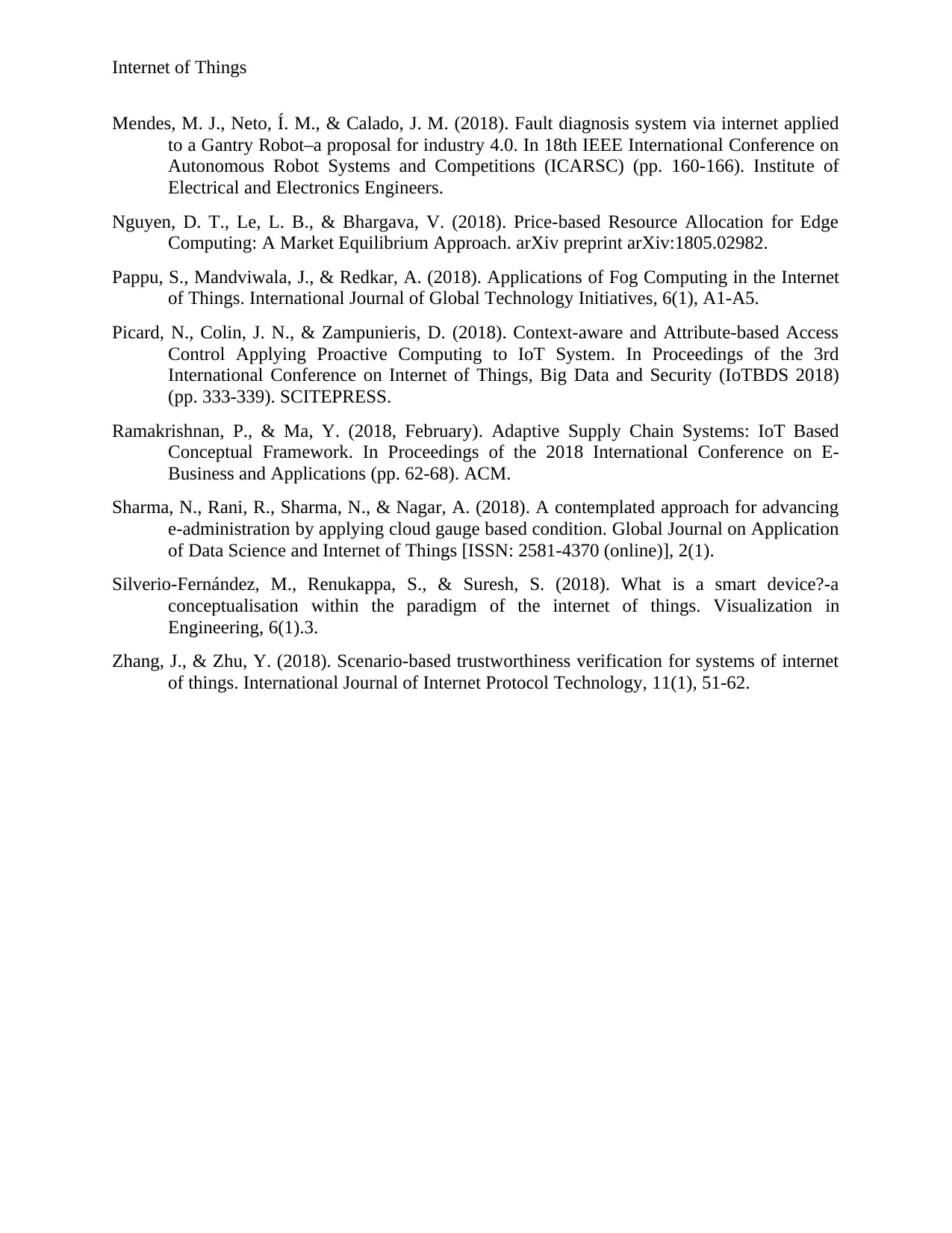
Internet of Things
Mendes, M. J., Neto, Í. M., & Calado, J. M. (2018). Fault diagnosis system via internet applied
to a Gantry Robot–a proposal for industry 4.0. In 18th IEEE International Conference on
Autonomous Robot Systems and Competitions (ICARSC) (pp. 160-166). Institute of
Electrical and Electronics Engineers.
Nguyen, D. T., Le, L. B., & Bhargava, V. (2018). Price-based Resource Allocation for Edge
Computing: A Market Equilibrium Approach. arXiv preprint arXiv:1805.02982.
Pappu, S., Mandviwala, J., & Redkar, A. (2018). Applications of Fog Computing in the Internet
of Things. International Journal of Global Technology Initiatives, 6(1), A1-A5.
Picard, N., Colin, J. N., & Zampunieris, D. (2018). Context-aware and Attribute-based Access
Control Applying Proactive Computing to IoT System. In Proceedings of the 3rd
International Conference on Internet of Things, Big Data and Security (IoTBDS 2018)
(pp. 333-339). SCITEPRESS.
Ramakrishnan, P., & Ma, Y. (2018, February). Adaptive Supply Chain Systems: IoT Based
Conceptual Framework. In Proceedings of the 2018 International Conference on E-
Business and Applications (pp. 62-68). ACM.
Sharma, N., Rani, R., Sharma, N., & Nagar, A. (2018). A contemplated approach for advancing
e-administration by applying cloud gauge based condition. Global Journal on Application
of Data Science and Internet of Things [ISSN: 2581-4370 (online)], 2(1).
Silverio-Fernández, M., Renukappa, S., & Suresh, S. (2018). What is a smart device?-a
conceptualisation within the paradigm of the internet of things. Visualization in
Engineering, 6(1).3.
Zhang, J., & Zhu, Y. (2018). Scenario-based trustworthiness verification for systems of internet
of things. International Journal of Internet Protocol Technology, 11(1), 51-62.
Mendes, M. J., Neto, Í. M., & Calado, J. M. (2018). Fault diagnosis system via internet applied
to a Gantry Robot–a proposal for industry 4.0. In 18th IEEE International Conference on
Autonomous Robot Systems and Competitions (ICARSC) (pp. 160-166). Institute of
Electrical and Electronics Engineers.
Nguyen, D. T., Le, L. B., & Bhargava, V. (2018). Price-based Resource Allocation for Edge
Computing: A Market Equilibrium Approach. arXiv preprint arXiv:1805.02982.
Pappu, S., Mandviwala, J., & Redkar, A. (2018). Applications of Fog Computing in the Internet
of Things. International Journal of Global Technology Initiatives, 6(1), A1-A5.
Picard, N., Colin, J. N., & Zampunieris, D. (2018). Context-aware and Attribute-based Access
Control Applying Proactive Computing to IoT System. In Proceedings of the 3rd
International Conference on Internet of Things, Big Data and Security (IoTBDS 2018)
(pp. 333-339). SCITEPRESS.
Ramakrishnan, P., & Ma, Y. (2018, February). Adaptive Supply Chain Systems: IoT Based
Conceptual Framework. In Proceedings of the 2018 International Conference on E-
Business and Applications (pp. 62-68). ACM.
Sharma, N., Rani, R., Sharma, N., & Nagar, A. (2018). A contemplated approach for advancing
e-administration by applying cloud gauge based condition. Global Journal on Application
of Data Science and Internet of Things [ISSN: 2581-4370 (online)], 2(1).
Silverio-Fernández, M., Renukappa, S., & Suresh, S. (2018). What is a smart device?-a
conceptualisation within the paradigm of the internet of things. Visualization in
Engineering, 6(1).3.
Zhang, J., & Zhu, Y. (2018). Scenario-based trustworthiness verification for systems of internet
of things. International Journal of Internet Protocol Technology, 11(1), 51-62.
⊘ This is a preview!⊘
Do you want full access?
Subscribe today to unlock all pages.

Trusted by 1+ million students worldwide
1 out of 9
Related Documents
Your All-in-One AI-Powered Toolkit for Academic Success.
+13062052269
info@desklib.com
Available 24*7 on WhatsApp / Email
![[object Object]](/_next/static/media/star-bottom.7253800d.svg)
Unlock your academic potential
Copyright © 2020–2025 A2Z Services. All Rights Reserved. Developed and managed by ZUCOL.





